What makes suman, a traditional Filipino rice cake, so beloved in the Philippines? Its unique preparation process adds to its cultural significance in Filipino cuisine. It’s a popular rice cake dessert.
Suman is a glutinous rice snack that’s a work of art. It’s often eaten as a dessert and sprinkled with sugar. This makes it a delightful food to enjoy. The sticky rice used for suman, called ‘malagkit’ by Filipinos, is key to its preparation.
The process of making suman involves soaking sticky rice overnight and cooking it for about 2 hours. This results in a delicious rice cake. It’s not only a staple in Filipino food but also a popular dessert.
Key Takeaways
- Suman is a traditional Filipino rice cake made from glutinous rice, typically served as a dessert.
- The preparation process involves soaking sticky rice overnight and cooking it for 2 hours.
- Suman is a popular food in the Philippines, with at least 15 varieties of rice used in its preparation.
- Each serving of suman contains approximately 56 calories and 1g of carbohydrates.
- Suman should be refrigerated at all times and can last about 3 to 5 days in the refrigerator.
- Suman is a significant part of Filipino cuisine, often enjoyed as a rice cake dessert.
What is Suman?
Suman is a traditional Filipino rice cake. It’s wrapped in banana leaves, coconut leaves, or buri palm leaves for steaming. It’s made from glutinous rice and coconut milk, using indigenous materials and techniques.
According to Filipino culinary traditions, suman is a long rice cake. It’s found in almost every town in the Philippines. There are over 10 types and many regional variations.
Definition and Origin
Suman is mainly made from glutinous rice and coconut milk. Some versions use cassava instead of glutinous rice. The mixture is wrapped in leaves for steaming, giving it a unique shape and flavor.
Cultural Significance
Suman is a big part of Filipino culture. It’s often eaten as a snack or dessert. Its wrapped shape and taste make it a favorite at Filipino celebrations and festivals.
The art of suman wrapping is also a key part of Filipino culture. Various geometric patterns and shapes are used. This makes the snack both unique and visually appealing.
Ingredients of Suman
To make suman, a traditional Filipino dish, you need a few key ingredients. Glutinous rice is the most common type used. It’s mixed with coconut milk, sugar, and a pinch of salt for flavor and aroma.
The beauty of suman lies in its simple ingredients. This makes it easy for everyone to enjoy. The recipe can also be tweaked to suit different tastes.
Some people add vanilla or pandan leaves to the mix. Coconut milk gives suman a rich, creamy texture. This makes it a tasty and fulfilling food choice.
Common Types of Rice Used
Glutinous rice, or sticky rice, is the go-to for suman. It has a high starch content. This makes it sticky and cohesive when cooked.
Flavoring Ingredients
There are many flavorings you can add to suman. Coconut milk, sugar, and salt are basics. You can also try vanilla or pandan leaves for different tastes.
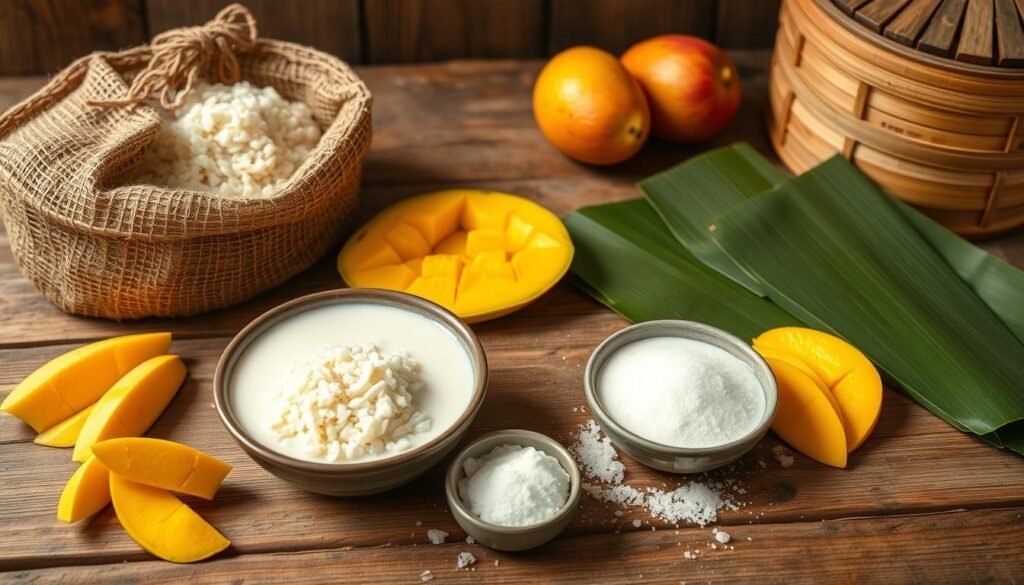
The ingredients for suman are simple yet versatile. This allows for many variations and flavors. Whether you’re after a traditional recipe or something new, suman is a delightful food choice.
Different Varieties of Suman
Suman is a traditional Filipino rice cake with many forms and flavors. Suman malagkit is a favorite, made from glutinous rice, often served at special events. Suman sa lihiya uses lye water for a unique texture and taste.
Each region in the Philippines has its own suman version. For example, Antipolo has suman sa ibus, and Samar has suman moron. These local sumans show the variety of rice cakes in the country. Suman latik, for instance, is wrapped in banana leaves and filled with sweet coconut.
Suman is a staple at festivals and celebrations, enjoyed as a snack or dessert. It’s a symbol of Filipino culture and history. Whether traditional or modern, suman celebrates the country’s rich culinary heritage.
| Variety | Ingredients | Wrapping Style |
|---|---|---|
| Suman Malagkit | Glutinous rice, coconut milk, sugar | Banana leaves |
| Suman sa Lihiya | Glutinous rice, lye water, coconut milk | Banana leaves |
| Suman Latik | Glutinous rice, coconut cream, sugar | Banana leaves |
The Process of Making Suman
To make suman, a traditional Filipino snack, you need to follow a specific recipe. First, prepare the rice. Then, wrap it in palm leaves and steam it. It takes about 20 minutes to prepare and 45 to 60 minutes to cook.
The recipe requires 2 cups of glutinous rice, 1 cup of sugar, and 1/3 can of coconut milk. Mix these ingredients together. Wrap them in banana leaves. The suman is ready when the liquid is absorbed, which takes 10 to 20 minutes of simmering.
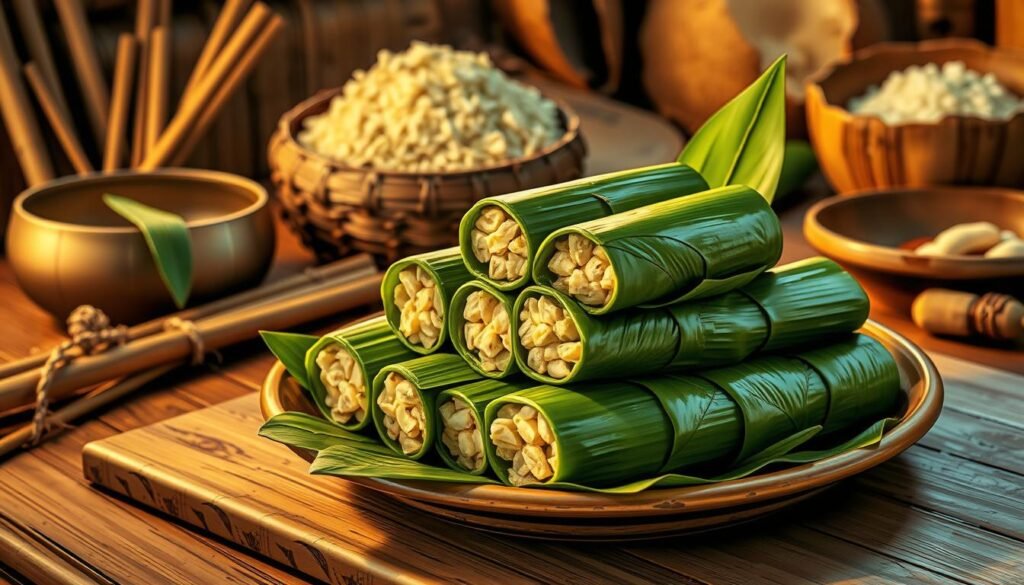
- Soak the glutinous rice overnight and then mix it with sugar, coconut milk, and salt.
- Wrap the mixture in banana leaves, leaving about 1 inch spacing on the edges.
- Steam the suman for 45 to 60 minutes to ensure complete cooking.
The result is a delicious and traditional Filipino snack. It can be served with sugar, sweetened grated coconut, latik, or ripe mango. This recipe shows how simple ingredients can make a tasty snack.
Health Benefits of Suman
Suman is a traditional Filipino rice cake with many health benefits. It’s made from glutinous rice and coconut milk. These ingredients make suman a good source of carbs, fiber, and minerals.
It’s also low in calories and fat. This makes suman a great choice for a healthy snack.
One serving of suman has about 170 calories. It has almost no fat or cholesterol. It also has a lot of amylopectin, which makes it sticky.
Using natural ingredients like glutinous rice and coconut milk is beneficial. It can lower the risk of chronic diseases and improve bone density.
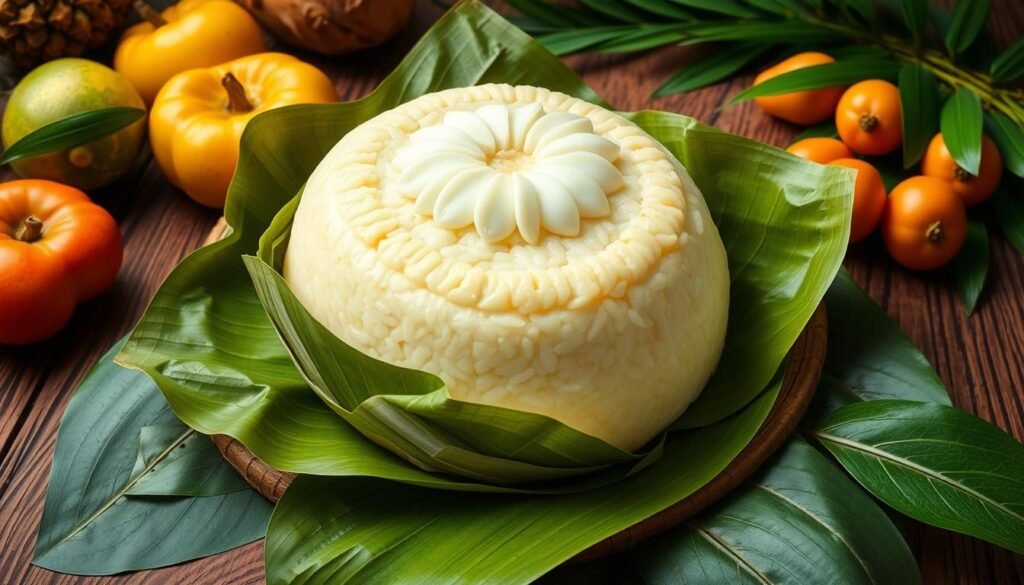
- Improved glycaemic control in patients with type-2 diabetes
- Lower risk of chronic diseases, such as heart disease and osteoporosis
- Higher bone density due to essential minerals present in glutinous rice
Suman is not just a tasty rice cake. It’s also a nutritious and healthy snack. Its health benefits and cultural significance make it a great choice for trying traditional Filipino food.
| Nutrient | Amount per serving |
|---|---|
| Calories | 170 |
| Fat | 0g |
| Cholesterol | 0mg |
| Carbohydrates | 40g |
Suman in Filipino Festivals
Suman is a key part of many Filipino festivals, most during the holiday season. It’s found in about 80% of festivals, each with its own twist. As a beloved snack, it’s often enjoyed during merienda, showing its importance in cultural events.
In places famous for suman, like San Pablo, over 90% of vendors sell Suman Lihiya. Making suman involves mixing malagkit (sticky rice), coconut milk, and salt. The leaves are cut on the same day for freshness. After hours of cooking, the wrapped suman is ready, bringing a taste of tradition to Filipino gatherings.
| Festival | Location | Featured Suman Variation |
|---|---|---|
| SuMaKaH Festival | Antipolo City | Suman sa Ibus |
| Suman Ibos Festival | Castillejos | Suman Lihiya |
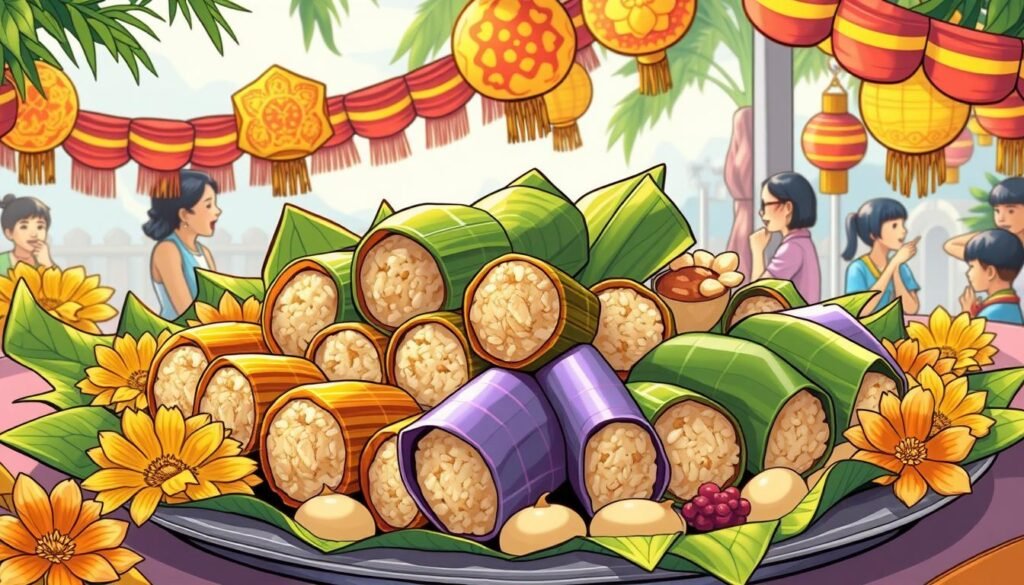
Suman’s cultural importance and tasty flavor make it a staple in Filipino festivals and celebrations. Whether it’s a snack or the main dish, suman is always a crowd-pleaser at Filipino events.
Pairing Suman with Other Foods
Suman, a traditional Filipino delicacy, can be enjoyed on its own or paired with various foods. It’s great with sweet or savory recipe combinations. For example, suman pairs well with fresh fruits like mangoes, which are common in the Philippines and cost just PHP30 per kilo in Batangas.
There are many ways to pair suman with other foods. You can serve it with grilled meats, steamed vegetables, or other Filipino delicacies like traditional dishes. Adding a sweet glaze or a spicy sauce can also enhance the flavor.
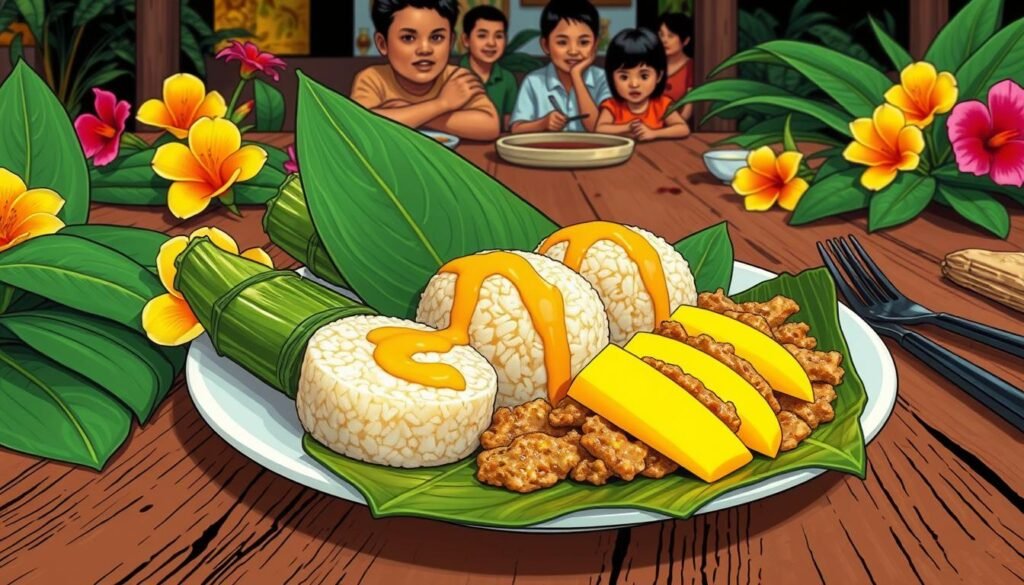
For recipe ideas, suman can be paired with many ingredients. Try it with coconut milk, a staple in Filipino recipes. Or, pair it with a mango salsa or a spicy peanut sauce for a unique taste.
Suman’s Role in Filipino Family Gatherings
Suman, a traditional Filipino rice cake, holds a special place in family gatherings. It symbolizes togetherness and tradition. It’s a must-have during holidays and celebrations in many Filipino homes.
Making suman is a labor of love that brings families closer. The process involves wrapping the rice cake in leaves. This tradition is passed down through generations, with each family having its own recipe and technique.
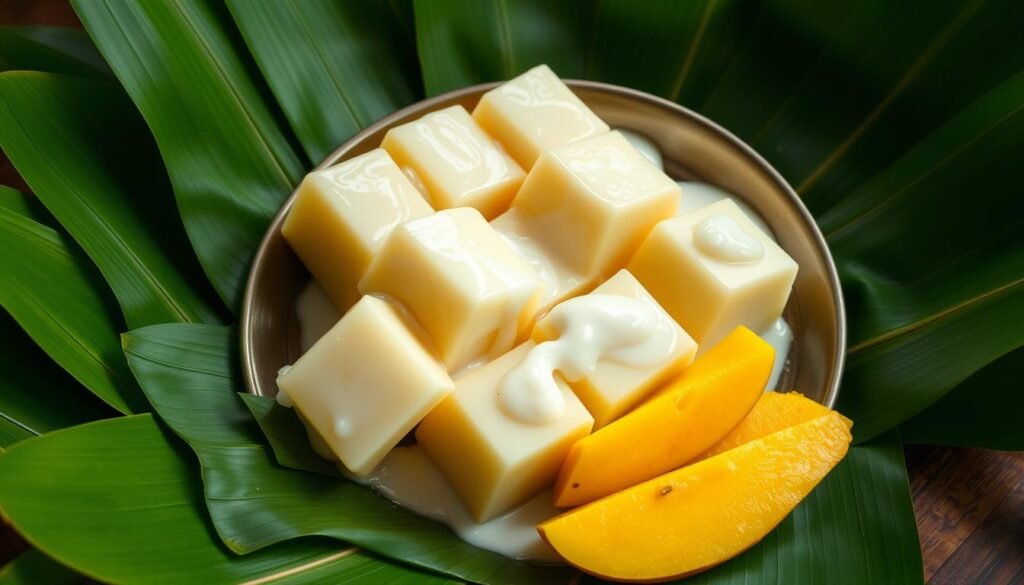
- As a snack or dessert
- As a side dish to complement other Filipino dishes
- As a gift or offer to guests
- As a symbol of hospitality and generosity
In Filipino culture, suman is more than food. It’s a wrapped bundle of love, tradition, and community. Its importance goes beyond family gatherings, representing the country’s history, culture, and values.
As a traditional rice cake, suman continues to be vital in Filipino family gatherings. It brings people together, fostering a sense of togetherness and belonging.
Regional Variations of Suman
Suman is a traditional Filipino snack with many regional flavors. Each area has its own recipe, ingredients, and cooking ways. This makes suman a diverse and exciting food to try.
In Antipolo, they make suman sa ibus with glutinous rice, salt, coconut milk, and turmeric. It’s often eaten as a snack or dessert.
In the Visayas, suman is a common food. Each province has its own special suman recipe. For example, Samar’s suman moron is sweet with real cacao or chocolate.
These variations come from different ingredients and cooking methods. They also reflect each region’s culture and history. To make suman, you need glutinous rice, coconut milk, and other ingredients. It’s great as a snack or in Filipino dishes.

Key ingredients in suman recipes are glutinous rice, coconut milk, and sugar. It’s steamed for about an hour. You can serve it with muscovado sugar or ripe mango.
The variety of suman shows Filipino cuisine’s creativity and adaptability. Whether you want a traditional snack or a unique dessert, suman is worth trying. Its many regional flavors make it a fascinating recipe to explore.
The Influence of Suman on Filipino Cuisine
Suman, a traditional Filipino rice cake, has greatly influenced the country’s cuisine. It’s a staple food, used in both savory and sweet dishes. Chefs love experimenting with suman, making it a key ingredient in modern Filipino cooking.
Recently, Filipino food has become famous worldwide. The NYCWFF has showcased Filipino dishes like palabok and ginataang alimasag. Suman, with its unique taste and texture, adds depth to these dishes.
Culinary historian Guillermo “Ige” Ramos Jr. says suman could be the Philippines’ national dish. It’s known for its chewy texture and mild flavor. Suman is a staple in Filipino cooking, paired with various ingredients to create tasty dishes. It inspires chefs and home cooks to try new recipes, enriching Filipino cuisine.
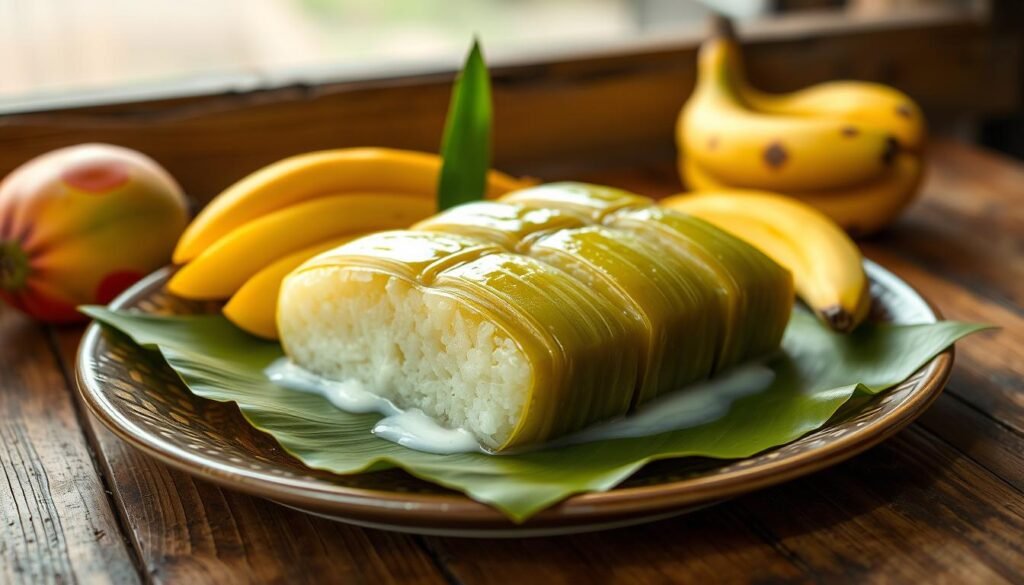
- Suman Malagkit: a sweet and sticky version of suman, often served with coconut and sugar
- Suman sa Lihiya: a traditional version of suman, made with lye water and often served with peanut sauce
- Suman Latik: a sweet and creamy version of suman, made with coconut milk and often served with fresh fruits
These variations show the diversity and richness of Filipino cuisine. Suman is a key part of the country’s culinary heritage. It continues to inspire new recipes and flavors, enriching the Filipino culinary experience.
How to Store Suman Properly
To keep your suman fresh, it’s key to store it right. After cooking, put it in an airtight container. This keeps it fresh for up to 2 days at room temperature.
For longer storage, you can refrigerate or freeze it. Refrigeration keeps it fresh for 5 days. Freezing can last months. Wrap it tightly in plastic or foil to avoid freezer burn. For more tips, visit suman storage tips.
Some important storage tips for suman are:
- Keep it away from sunlight and moisture
- Store it in an airtight container
- Label and date the container for easy tracking
By following these tips, you can enjoy suman longer. Always check for spoilage before eating. Store it in a cool, dry place to keep its quality.
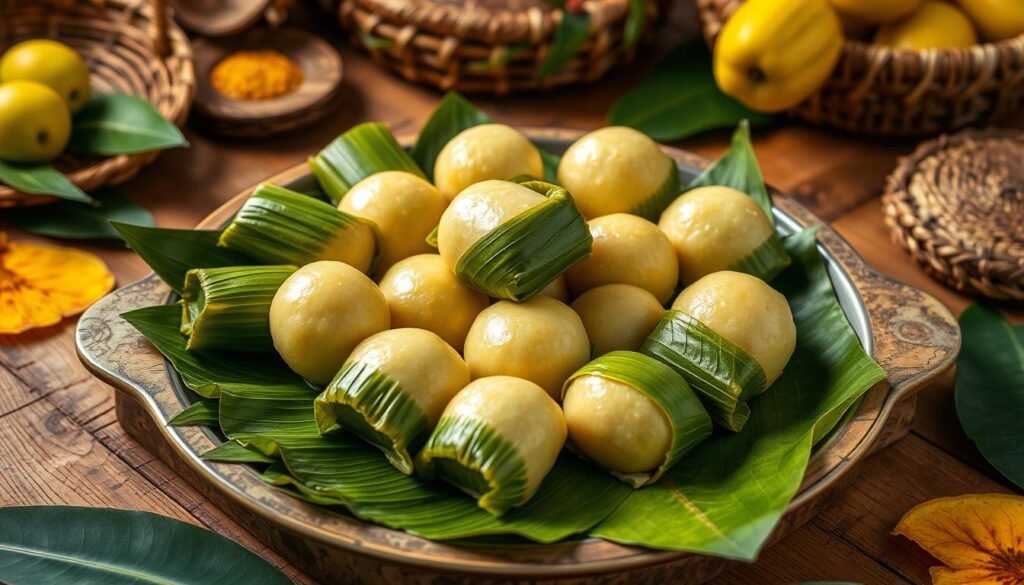
Finding Suman in the Philippines
To taste the real suman, visit traditional markets and food stalls in the Philippines. These places have many food choices, including suman, a favorite Filipino recipe. The third web source says suman is found in these markets and stalls, making it easy for everyone to find it.
Places like Café Adriatico and Legaspi Sunday Market are great spots for suman. Café Adriatico sells suman sa lihiya for Php 129. Legaspi Sunday Market is open from 7 AM to 2 PM on Sundays. Salcedo Community Market in Makati is also a good choice, though the hours are not mentioned.
When buying suman, look at the recipe and ingredients used. Also, check the price, which can be around 120 pesos for 12 pieces of suman sa lihiya.
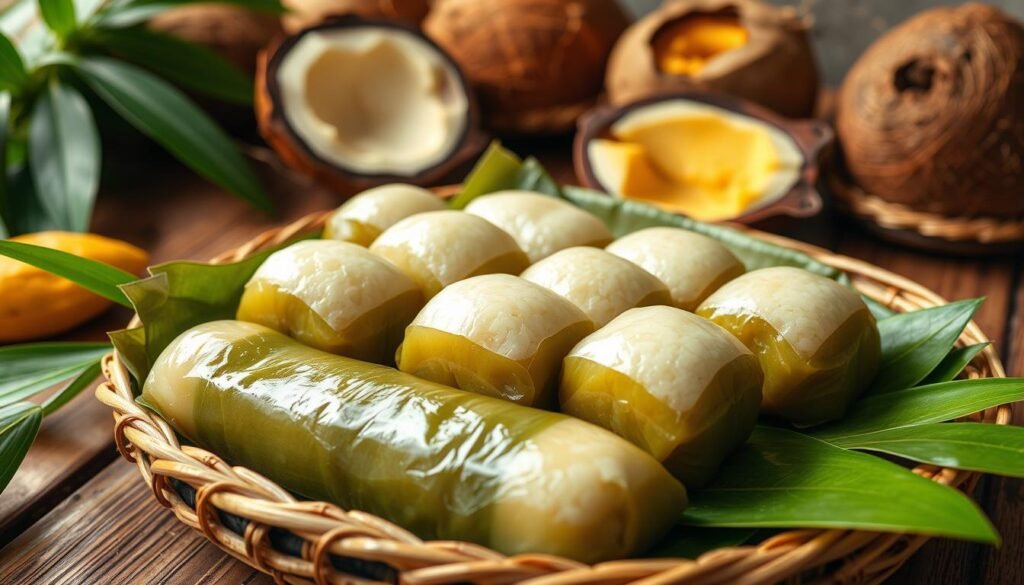
Aside from markets and restaurants, suman is also sold by street vendors across the Philippines. For the best taste, try suman at a local recipe expert or a famous food spot. This way, you’ll get to enjoy the true flavor of suman and the Philippines’ unique food culture.
Suman as a Gift Item
Suman, a traditional Filipino rice cake, is a thoughtful gift for any occasion. It beautifully showcases the country’s rich cultural heritage. A wrapped rice cake is not only a delicious treat but also a symbol of love and appreciation.
For those looking to give suman as a gift, there are various presentation ideas to consider. You can pair it with other local delicacies, such as fresh fruits or nuts, to create a unique gift basket. Another idea is to wrap the suman in a beautifully designed cloth or paper, highlighting the traditional Filipino wrapping techniques.
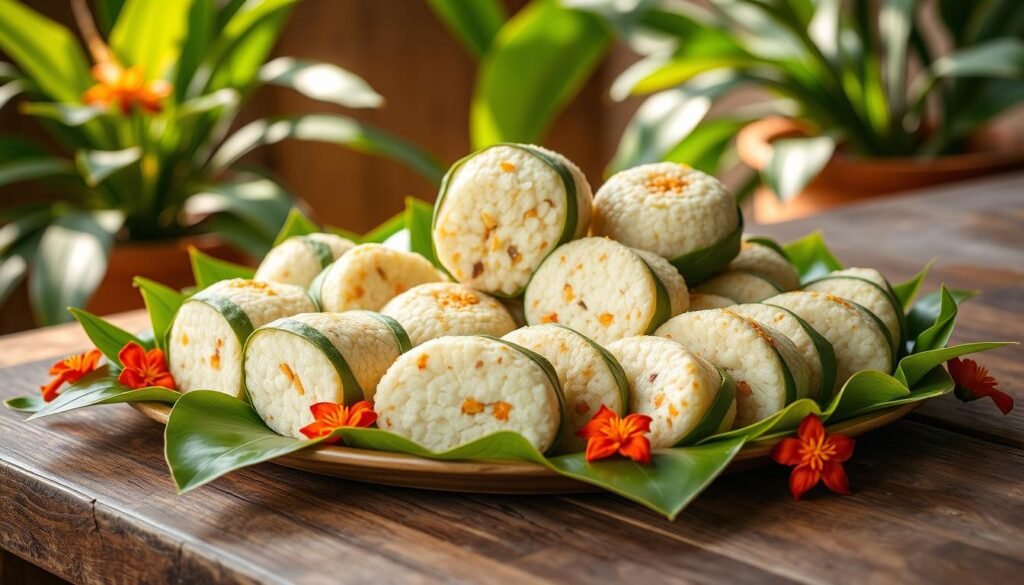
- Placing it in a decorative basket or container
- Wrapping it in a colorful cloth or paper
- Pairing it with other Filipino delicacies
These presentation ideas not only add to the aesthetic appeal of the suman but also showcase the thought and effort put into selecting a unique and meaningful gift.
In Filipino culture, giving suman as a gift is a way to show respect and appreciation for the recipient. The traditional rice cake is often served at special occasions, such as weddings and holidays. It is a symbol of unity and togetherness. By giving suman as a gift, you are sharing a part of Filipino culture and tradition with the recipient.
The Global Appeal of Suman
Suman, a traditional Filipino rice cake, is becoming more popular around the world. It’s seen as a unique and tasty snack. This rise in popularity is due to people’s growing interest in international foods and wanting to try new recipe ideas.
A study found that the demand for healthier foods and local treats has boosted suman’s market. Now, suman is enjoyed not just in the Philippines but also in other countries. It’s often served as a snack or used in different recipe ideas.
Suman’s versatility has made it a favorite in many international recipe variations. It can be combined with various flavors and ingredients. This makes it a great addition to any meal or snack. With its growing popularity, suman is set to become a key part of many international cuisines.
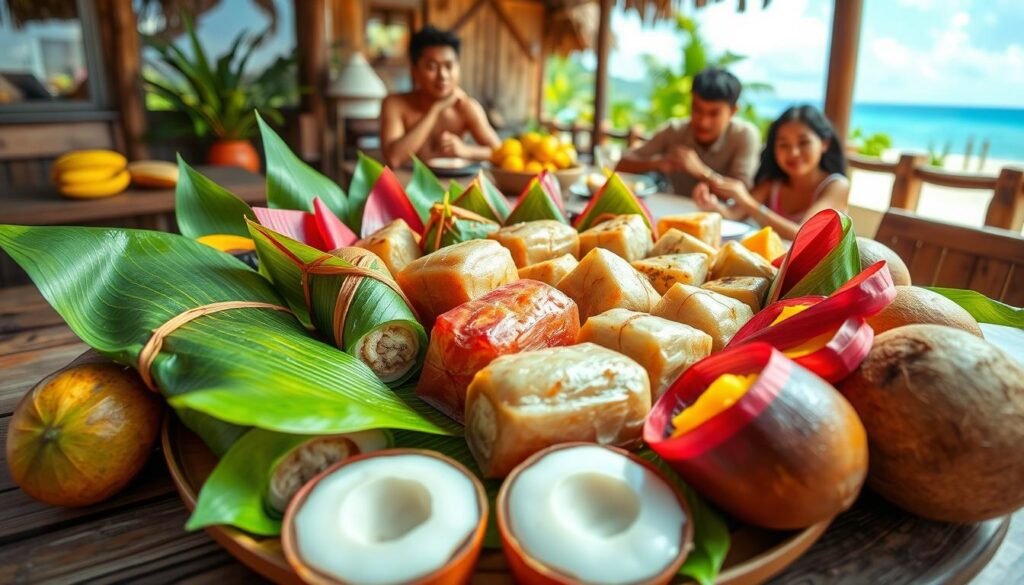
- As a side dish to complement other Filipino dishes
- As an ingredient in salads or stir-fries
- As a base for creative recipe ideas, such as suman cakes or suman pudding
The global appeal of suman shows how food can unite people and cross cultural lines. Whether enjoyed as a snack or in a new recipe, suman is sure to please people of all ages and backgrounds.
Conclusion: Preserving the Art of Suman
Exploring Antipolo’s cultural heritage shows us suman-making is more than food. It’s a symbol of Filipino strength and creativity. Manang Anita’s 50+ years of making suman remind us of the value of keeping our traditions alive.
Manang Anita’s bayi-bayi is a hit during All Saints’ Day. It shows how suman is key to Filipino celebrations. Every P5 suman sold by Manang Norma connects us to our shared history.
With younger people preferring new food options, we must protect suman-making. Teaching the next generation these recipes keeps suman’s unique taste and cultural value alive. This way, suman will remain a beloved part of Filipino food for years to come.
FAQ
What is suman?
Suman is a traditional Filipino rice dish. It’s wrapped in leaves and steamed. It’s a favorite snack and a big part of Filipino culture.
What is the cultural significance of suman?
Suman is very important in the Philippines. It’s a big part of festivals and celebrations. Making and wrapping suman is seen as an art form.
What ingredients are used to make suman?
To make suman, you need different types of rice. You also use coconut milk, brown sugar, and pandan leaves for flavor.
What are the different varieties of suman?
There are many types of suman. Some popular ones are suman malagkit, suman sa lihiya, and suman latik. Each has its own special ingredients and taste.
How is suman made?
Making suman starts with preparing the rice. Then, the rice mix is wrapped in leaves. After that, it’s steamed or boiled. Wrapping it is an art.
What are the health benefits of suman?
Suman is a healthy snack. It’s made with natural ingredients and no artificial preservatives. It’s good for a balanced diet.
How is suman used in Filipino festivals and celebrations?
Suman is a key part of many Filipino celebrations. It’s made and shared during Christmas, New Year, and other festivals. It shows its cultural importance.
How can suman be paired with other foods?
Suman goes well with many foods. You can enjoy it alone or with sweet coconut, caramelized coconut, or savory dishes like salted eggs.
How is suman passed down in Filipino families?
Suman recipes are passed down through generations. The way it’s made and wrapped is a family tradition. It brings families together.
How do regional variations of suman differ?
Suman varies by region in the Philippines. Ingredients, wrapping styles, and cooking methods differ. For example, Ilocano, Visayan, and Mindanaoan suman are all unique.
How has suman influenced Filipino cuisine?
Suman has greatly influenced Filipino food. Its versatility makes it a favorite in modern dishes and fusion cuisine. It’s very popular.
How should suman be stored?
To keep suman fresh, store it properly. Refrigerate or freeze it for short-term storage. For longer storage, try drying or preserving.
Where can suman be found in the Philippines?
You can find suman in traditional markets, food stalls, and restaurants. It’s a great way to try authentic Filipino flavors.
How can suman be used as a gift item?
Suman is a great gift because of its cultural value and unique presentation. It’s a thoughtful gift for any occasion.
How is suman gaining global appeal?
As Filipino food becomes more known worldwide, suman is becoming more popular too. It’s enjoyed in many countries, showing the love for Filipino culture.
Source Links
- Suman sa Ibus – Filipino Sticky Rice Logs – https://thequirinokitchen.com/suman-sa-ibus-filipino-sticky-rice-logs/
- The Happy Home Cook: Suman sa Ibus – Sticky Rice Logs — Positively Filipino | Online Magazine for Filipinos in the Diaspora – https://www.positivelyfilipino.com/magazine/the-happy-home-cook-suman-sa-ibus-sticky-rice-logs
- Suman (food) – https://en.wikipedia.org/wiki/Suman_(food)
- Suman Malagkit (Filipino Steamed Rice Cakes) – https://sweetsimplevegan.com/suman-malagkit/
- Suman Malagkit – Foxy Folksy – https://www.foxyfolksy.com/suman-malagkit/
- Suman Malagkit with Coconut Caramel Sauce – https://www.kawalingpinoy.com/suman-malagkit-with-coconut-sauce/
- Varieties of Suman in Aklan: Suman Ibos, Suman Latik & Suman Kamoteng Kahoy – https://bertietalimongan.wordpress.com/2020/04/29/varieties-of-suman-in-aklan-suman-ibos-suman-latik-suman-kamoteng-kahoy/
- Suman Malagkit – https://theunlikelybaker.com/suman-recipe-filipino-sticky-rice-cake-banana-leaves/
- List of suman varieties – http://glossaryoffilipinofood.blogspot.com/2014/03/list-of-suman-varieties.html
- Sticky Rice in Banana Leaves (Suman Malagkit) – Jeanelleats Food and Travel Blog – https://jeanelleats.com/sticky-rice-in-banana-leaves-suman-malagkit/
- Suman Malagkit Recipe – https://pilipinasrecipes.com/suman-malagkit-recipe/
- Suman: Origin and Benefits – https://juankakanin.wordpress.com/2014/10/27/suman-origin-and-benefits/
- Suman: Origin and Benefits – https://maricazenia.wordpress.com/2017/10/05/suman-origin-and-benefits/
- 6 Proven Benefits of Sticky Rice (Glutinous Rice) | Organic Facts – https://www.organicfacts.net/sticky-rice.html
- How Suman Sealed The Deal – https://amommabroad.wordpress.com/2017/06/06/how-suman-sealed-the-deal/
- Suman Ibos Festival 2019 – Municipality of Castillejos – http://castillejos.com.ph/suman-ibos-festival-2019/
- Local Delicacy at its Finest – https://thehappyandgayexperience.wordpress.com/2017/11/20/making-suman-sa-ibos/
- Puto or Suman with Grilled Mango a la Marketman… – Market Manila – https://www.marketmanila.com/archives/puto-suman-grilled-mango
- Suman sa Lihiya Recipe – https://panlasangpinoy.com/suman-sa-lihiya/
- RECIPE: Suman con Chocolate — Eat & Drink – https://asianjournal.com/life-style/eat-drink/suman-con-chocolate/
- [New School] Keeping up with the ‘suman’: Heritage food in a changing society – https://www.rappler.com/voices/imho/opinion-keeping-up-suman-heritage-food-changing-society/
- Reverence for suman – IFEXConnect – https://www.ifexconnect.com/story/reverence-for-suman
- Suman: Exploring the Cultural Significance and Varieties of a Filipino Staple – pinascuisine.com – https://pinascuisine.com/suman/
- Suman (Filipino Steamed Sticky Rice Cakes) – https://www.seriouseats.com/suman-filipino-steamed-sticky-rice-cakes-7152847
- Lumpia, palabok, reimagined suman: Filipino dishes draw crowds at NYCWFF — Eat & Drink – https://asianjournal.com/life-style/eat-drink/lumpia-palabok-reimagined-suman-filipino-dishes-draw-crowds-at-nycwff/
- ‘Suman’ as Philippine national food—agree? – https://lifestyle.inquirer.net/359467/suman-as-philippine-national-food-agree/
- Filipino cuisine – https://en.wikipedia.org/wiki/Filipino_cuisine
- SUMAN (Steamed Sweet Sticky Rice Rolls) – https://www.busogsarap.com/2010/10/suman-steamed-sweet-sticky-rice-rolls.html
- Suman Malagkit Recipe – https://www.recipesbynora.com/suman-malagkit-recipe/
- The Gluttonous Rice Cake that will Stick to your Mind – https://medium.com/@viensierra/the-gluttonous-rice-cake-that-will-stick-to-your-mind-db1636110c3
- I finally found (Su-man) – https://foodtechpinoy.wordpress.com/2015/10/31/i-finally-found-su-man/
- Suman in Manila | Eat Your World – https://eatyourworld.com/destinations/asia/philippines/manila/what-to-eat/suman
- SUMAN: Philippine Rice Cake Rolls – https://www.budbudgourmetsuman.com/
- Suman Majumdar – https://www.burnet.edu.au/people-of-burnet/people/suman-majumdar/
- A few lessons from the beautiful game – https://medium.com/@sumanreddy89/a-few-lessons-from-the-beautiful-game-a4e1adec0098
- “Suman, Ibos and Bayi-Bayi” – https://theunknownartblog.wordpress.com/2016/12/05/suman-ibos-and-bayi-bayi/
- Interpreting wall arts of Rajamundhry, A morning run across cultural capital of AP – Dr Suman Das – https://drsumandas.com/interpreting-rajamundhry-wall-art/

